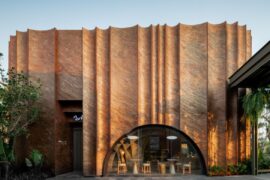As the Australian design industry continues to boom, we take a closer look at what this means for the commercial property sector.

As we’ve previously reported, the commercial design industry is in the throes of a boom period. Demographic shifts, a strong national economy, and an intensely competitive market have shaped a design industry that is faster, bolder, and more efficient than ever.
While this evolution is remarkable, it has not occurred in a vacuum. Rather, the growth of commercial design has paralleled the expansion of another critical Australian industry: commercial property.
Indeed, the symbiotic relationship between commercial design and property is one of the best embodiments of the new ecosystem driving innovation and development today. Commercial design and property reflect one another more closely than perhaps any other pairing of industries: expansion in design bolsters growth in property, and vice versa.
The two disparate disciplines inform and shape one another, often reflecting twin peaks in periods of growth and twin troughs in times of downturn.
The effects of a strong property market in the design industry are well known, and include enhanced competition and innovation, increased demand for service, and the creation of new jobs. In short, a thriving property market is a veritable playground for designers seeking to hone their skills and make a name for themselves.
In return, a vibrant design industry bolsters growth in the property sector by enticing new investors and adding value to otherwise run-of-the-mill properties. But what else is behind the Australian commercial property boom? And what are the critical factors that you need to be mindful of?
As always, the reality is more complex than it first appears. Australia’s commercial design market is buoyed by an interplay of factors that converge to create the perfect incubator for growth.
Simply put, now is a good time to invest in Australian commercial real estate. Dissuaded by low return rates on cash assets, investors across the country are turning to commercial property, where yields remain high: according to Colliers International’s Metro Office Research and Forecast Report for the first half of 2018, investment returns in metro office markets are at a 10-year high. This is predicted to continue in the coming years, particularly in CBD fringes.
As with commercial design, growth in commercial property is driven largely by deep pockets. At the end of 2017, CBRE reported that foreign investment now accounts for a third of commercial property transactions across the country, making Australia the top destination for cross-border capital in the world. Asia has emerged as the key source of investment in Australian property, with the region accounting for an estimated US$1.6 billion of capital injection in 2017 alone.
The commercial property market is both stronger and broader than ever. As rent in premium inner city locations rises and availability drops dramatically, occupiers are seeking alternative locations beyond CBDs. This factor, coupled with enhanced road and transport infrastructure, means that investment in property outside the central city is an increasingly viable prospect. Former fringe locations are now property hotbeds: according to Colliers International, some markets outside the CBD – including Parramatta and Melbourne’s city fringe – are now more densely occupied than the Sydney and Melbourne CBDs.
Location is not the only respect in which Australian commercial property is diversifying. Recent years have also seen marked growth in properties that would otherwise be withdrawn from the market through adaptive reuse and refurbishment.
Property professionals must be mindful of commercial stock withdrawal, an undercurrent that is emerging from this period of industry growth. This is particularly relevant in metro markets such as Sydney and Brisbane, where 40,000-square-metres and 34,000-square-metres respectively of commercial stock were withdrawn over the past 12 months.
As Knight Frank’s former Head of Research Matt Whitby explained to Real Commercial, redevelopment for residential and hotel use accounts for the bulk of commercial withdrawals, particularly in capital cities.
While this is not necessarily a threat to industry growth – scarcity does, after all, control demand – property professionals must be prepared to deal with the increased level of competition that reduced stock will bring.
Environmental certification and sustainability credentials are increasingly central considerations for occupants selecting office and other commercial space. In Australia, there are currently over 100 offices with a 6-star or above Green Star rating: to remain competitive and attract high quality, long term tenants, it is evident that property professionals need to continue to leverage – and invest in – green design.
The Australian market for commercial design is booming. Now is the time to get in front. For more vital information that you need to help you think creatively about property and get ahead of the curve, register to attend for FRONT today.
A searchable and comprehensive guide for specifying leading products and their suppliers
Keep up to date with the latest and greatest from our industry BFF's!

Elevate any space with statement lighting to illuminate and inspire.

Vert, an innovative demountable pergola designed for urban greening, is reshaping the way we think about sustainability in urban architecture.

Within the intimate confines of compact living, where space is at a premium, efficiency is critical and dining out often trumps home cooking, Gaggenau’s 400 Series Culinary Drawer proves that limited space can, in fact, unlock unlimited culinary possibilities.

Resonant colour, rich materiality and thoughtful spatial planning create a highly functional and beautiful office for BresicWhitney in Mosman, Sydney.

This event talked to (literally) innovative design and reaffirmed Designer Rugs’ commitment to building a thriving community within the architecture and design landscape, where guests heard from the likes of the revered Anna-Carin.
The internet never sleeps! Here's the stuff you might have missed

IDIN Architects creates another spectacular project following its win in The Social Space category at the 2024 INDE.Awards.

The $160 million transformation of 500 Bourke Street in Melbourne’s CBD has revitalised a 1970s Brutalist icon, originally designed by Godfrey & Spowers.